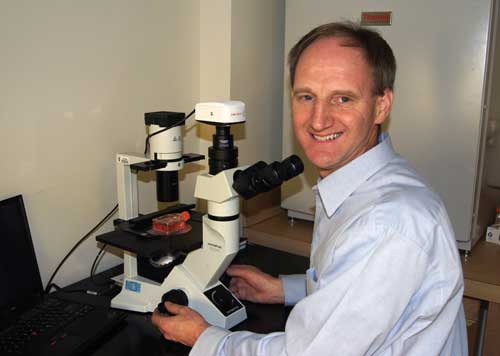Roy Golsteyn is an associate professor of biology and an Alberta Ingenuity faculty member at the University of Lethbridge.
He directs the Cancer Cell Laboratory where his team studies the problem of how cancer cells escape a cancer treatment. The majority of cancer patients in Canada will receive some form of treatment, such as chemotherapy or radiation, and unfortunately these treatments are not as successful as we would like them to be.
To improve them, we need to understand all the steps that occur after a treatment. Golsteyn's research team has developed a new experimental system that uses microscopes and special biological tools to study how cancer cells react to treatments. They have found that after a treatment, cancer cells will divide one more time, a "double-or-nothing" gamble called checkpoint adaptation that may produce cells that are resistant to future treatments.

Golsteyn's laboratory studies checkpoint adaptation in collaboration with biotechnology companies and the pharmaceutical industry, with the goal of helping doctors improve treatments for cancer patients.
What first piqued your interest in your research discipline?
I actually recall clearly when I first became interested in cancer research. I was a research fellow at the Institute Curie. At that time, a medical research laboratory had published the results of a clinical trial in which a new anti-cancer drug was tested. The trial was deemed to be successful, and yet upon studying the results I was stunned to learn that many of the patients in the clinical trial succumbed to the disease. It was then that I realized just how difficult the disease is, and that doctors and patients need better treatments.
How is your research applicable in "the real world"?
I am a basic research scientist who studies cancer cells. In my laboratory, our goal is to contribute to the cure. Cancer is a major disease that touches many people, including indirectly our family and friends. We sometimes collaborate with biotechnology companies and with the pharmaceutical industry, in which case we focus on real world problems such as improving existing cancer drugs.
What is the greatest honour you have received in your career?
The greatest honour is leading research projects that are funded by charitable donations. People generously give their money without asking precisely how it will be used. We try to meet this honour by doing the best research that we can and by sharing our knowledge as quickly as possible.
How important are students to your research endeavours?
Students are the lifeblood of research. When we train them, we quickly see the weak points in our own knowledge. When they become autonomous, they think of questions that we had not yet even imagined and thus they push at the old barriers in science. Finally, the best students have incredible energy and an open mind, something that we seem to lose as we get older. We need students in research.
If you had unlimited funds, which areas of research would you invest?
Very simple. Rather than funding an area of research, I would fund scientists who are very motivated and propose a well thought-out question. Motivated people get things done, so it seems natural to help them go to work. Our best ideas come from the imagination, not from instructions. Our knowledge about how cancer cells divide came from someone who studied cell division in sea urchin eggs. It was not expensive research, but it was amongst the most valuable and that made it an excellent investment.
Each month, the Legend will present 5 Questions With . . . one of our researchers. For a look at the entire catalog of 5 Questions With . . . features, check out the Office of Research and Innovation Services website at www.uleth.ca/research/research_profiles. If you'd like to be profiled, contact Penny Pickles at pickpj@uleth.ca
This story first appeared in the February 2012 edition of The Legend. To view the full issue in a flipbook format, follow this link.
